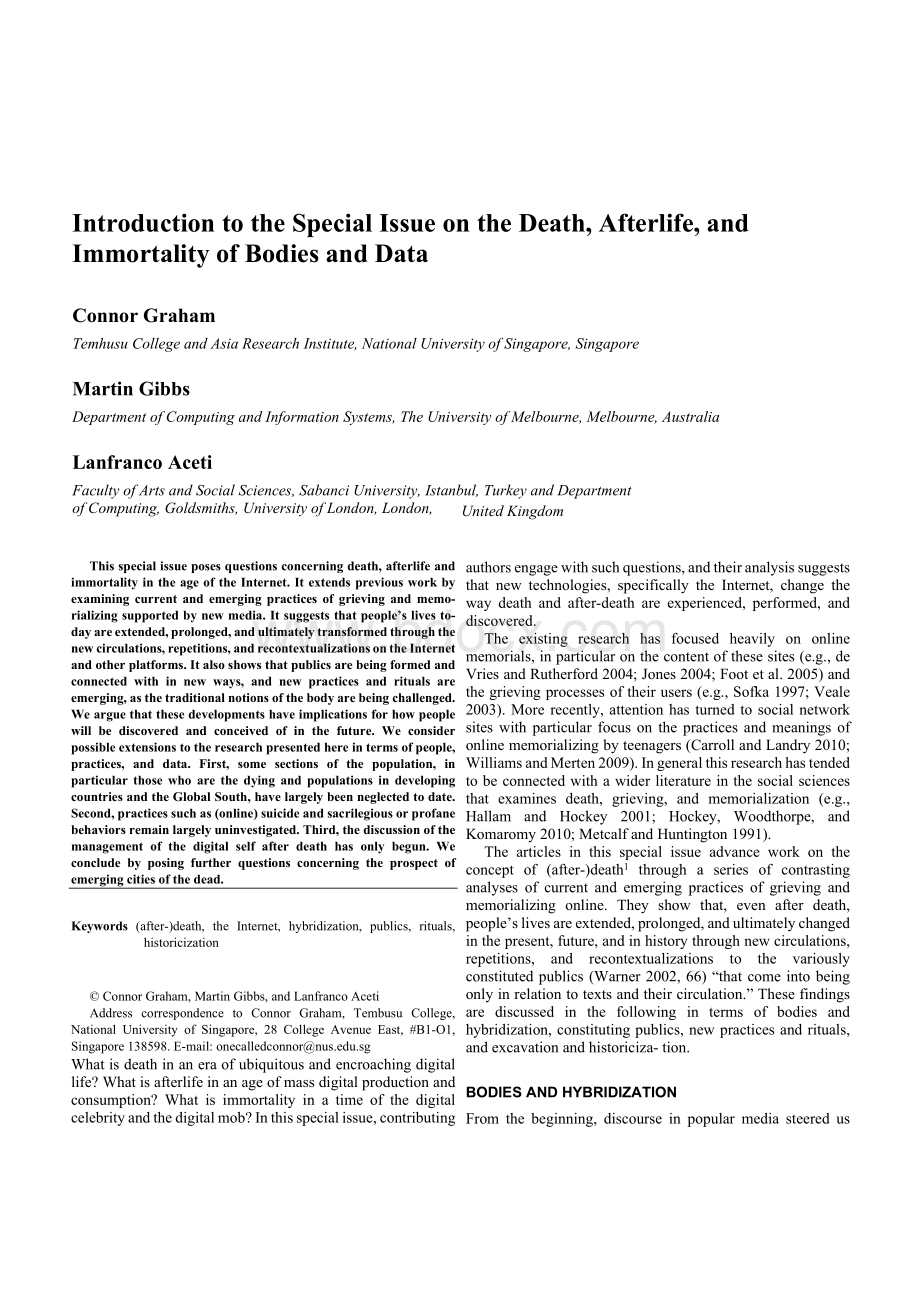Introduction to the Special Issue on the Death, Afterlife, and…Word格式.docx
《Introduction to the Special Issue on the Death, Afterlife, and…Word格式.docx》由会员分享,可在线阅读,更多相关《Introduction to the Special Issue on the Death, Afterlife, and…Word格式.docx(8页珍藏版)》请在冰豆网上搜索。

MartinGibbs
DepartmentofComputingandInformationSystems,TheUniversityofMelbourne,Melbourne,Australia
LanfrancoAceti
FacultyofArtsandSocialSciences,SabanciUniversity,Istanbul,TurkeyandDepartment
UnitedKingdom
ofComputing,Goldsmiths,UniversityofLondon,London,
Thisspecialissueposesquestionsconcerningdeath,afterlifeandimmortalityintheageoftheInternet.Itextendspreviousworkbyexaminingcurrentandemergingpracticesofgrievingandmemo�rializingsupportedbynewmedia.Itsuggeststhatpeople’slivesto�dayareextended,prolonged,andultimatelytransformedthroughthenewcirculations,repetitions,andrecontextualizationsontheInternetandotherplatforms.Italsoshowsthatpublicsarebeingformedandconnectedwithinnewways,andnewpracticesandrit�ualsareemerging,asthetraditionalnotionsofthebodyarebeingchallenged.Wearguethatthesedevelopmentshaveimplicationsforhowpeoplewillbediscoveredandconceivedofinthefuture.Weconsiderpossibleextensionstotheresearchpresentedhereintermsofpeople,practices,anddata.First,somesectionsofthepopulation,inparticularthosewhoarethedyingandpopulationsindevelopingcountriesandtheGlobalSouth,havelargelybeenneglectedtodate.Second,practicessuchas(online)suicideandsacrilegiousorprofanebehaviorsremainlargelyuninvestigated.Third,thediscussionofthemanagementofthedigitalselfafterdeathhasonlybegun.Weconcludebyposingfurtherquestionsconcerningtheprospectofemergingcitiesofthedead.
Keywords(after-)death,theInternet,hybridization,publics,rituals,historicization
©
ConnorGraham,MartinGibbs,andLanfrancoAceti
AddresscorrespondencetoConnorGraham,TembusuCollege,NationalUniversityofSingapore,28CollegeAvenueEast,#B1-O1,Singapore138598.E-mail:
onecalledconnor@nus.edu.sg
Whatisdeathinaneraofubiquitousandencroachingdigitallife?
Whatisafterlifeinanageofmassdigitalpro�ductionandconsumption?
Whatisimmortalityinatimeofthedigitalcelebrityandthedigitalmob?
Inthisspecialissue,contributingauthorsengagewithsuchquestions,andtheiranalysissuggeststhatnewtechnologies,specif�icallytheInternet,changethewaydeathandafter-deathareexperienced,performed,anddiscovered.
Theexistingresearchhasfocusedheavilyononlinememorials,inparticularonthecontentofthesesites(e.g.,deVriesandRutherford2004;
Jones2004;
Footetal.2005)andthegrievingprocessesoftheirusers(e.g.,Sofka1997;
Veale2003).Morerecently,attentionhasturnedtosocialnetworksiteswithparticularfocusonthepracticesandmeaningsofonlinememorializingbyteenagers(CarrollandLandry2010;
WilliamsandMerten2009).Ingeneralthisresearchhastendedtobeconnectedwithawiderliteratureinthesocialsciencesthatexaminesdeath,grieving,andmemorialization(e.g.,HallamandHockey2001;
Hockey,Woodthorpe,andKomaromy2010;
MetcalfandHuntington1991).
Thearticlesinthisspecialissueadvanceworkontheconceptof(after-)death1throughaseriesofcontrastinganalysesofcurrentandemergingpracticesofgrievingandmemorializingonline.Theyshowthat,evenafterdeath,people’slivesareextended,prolonged,andultimatelychangedinthepresent,future,andinhistorythroughnewcirculations,repetitions,andrecontextualizationstothevariouslyconstitutedpublics(Warner2002,66)“thatcomeintobeingonlyinrelationtotextsandtheircircu�lation.”Thesefindingsarediscussedinthefollowingintermsofbodiesandhybridization,constitutingpublics,newpracticesandrituals,andexcavationandhistoriciza-tion.
BODIESANDHYBRIDIZATION
Fromthebeginning,discourseinpopularmediasteeredustowardagrowingsenseofanotherself,anotionofaselfthatisdigitallydistributedacrosstextmessages,Webpages,socialnetworkingsites,blogcomments,andsoon:
adigitalself.Aroundthetimethattheproposalwasconceived,inTimemagazineFaure(2009)suggestedthatthecapacityofinformationandcommunicationtechnolo�gies(ICTs)raisedimportantquestionsregardinglegacyandcuration:
“Aspeoplespendmoretimeatkeyboards,there’slessbeingstoredawayindustyatticsforfamilyandfriendstohangonto”(online).ButFaurewentfur�therthansimplydescribingconcernsaboutarchivingandstoragetoaskaquestionthatsuggestedsomeanxietyandevenresentmentaboutaburgeoningandenduringself:
“Thepiecesofourlivesthatweputonlinecanfeelaseter�nalastheInternetitself,butwhathappenstoourvirtualidentityafterwedie?
”(online).Bollmer(2013),inthisissue,suggeststhatthistensionbet